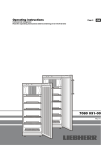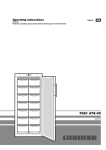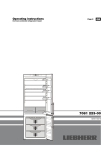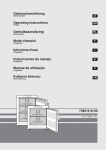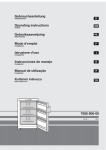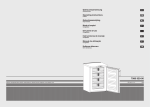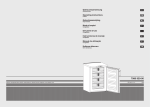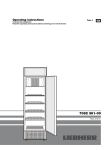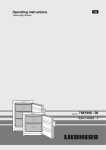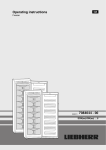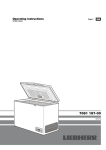Download Liebherr Freezer 7080 904-00 User's Manual
Transcript
Gebrauchsanleitung
D
Gefrierschrank
Operating instructions
GB
Freezer
Gebruiksaanwijzing
NL
Diepvrieskast
Mode d'emploi
F
Congelateur
Istruzione d'uso
I
Congelatore
Instrucciones de manejo
E
Congelador
Manual de utilização
P
Congelador
Kullanım kılavuzu
TR
Derin dondurucu
7080 904-00
G 12....
2411
Disposal notes
Safety instructions and warnings
The packaging is made of recyclable materials.
• To prevent injury or damage to the unit, the appliance should
be unpacked and set up by two people.
• In the event that the appliance is damaged on delivery, contact
the supplier immediately before connecting to the mains.
• To guarantee safe operation, ensure that the appliance is set
up and connected as described in these operating instructions.
• Disconnect the appliance from the mains if any fault occurs.
Pull out the plug, switch off or remove the fuse.
• When disconnecting the appliance, pull on the plug, not on the
cable.
• Any repairs and work on the appliance should only be carried
out by the customer service department, as unauthorised work
could prove highly dangerous for the user. The same applies to
changing the mains power cable.
• Do not allow naked flames or ignition sources to enter the appliance. When transporting and cleaning the appliance ensure
that the refrigerant circuit is not damaged. In the event of damage, make sure that there are no ignition sources nearby and
keep the room well ventilated.
• Do not stand on the plinth, drawers or doors or use them to
support anything else.
• This appliance is not intended for use by persons (including
children) with reduced physical, sensory or mental capabilities or
lack of experience and knowledge unless they have been given
initial supervision or instruction concerning use of the appliance
by a person responsible for their safety. Children should be supervised to ensure that they do not play with the appliance.
• Avoid prolonged skin contact with cold surfaces or chilled/
frozen food. This could cause pain, numbness and frostbite.
In the case of prolonged skin contact, protective measures
should be taken, e.g. gloves should be worn.
• Do not eat ice cream, particulary ice lollies or ice cubes, immediately after taking them from the freezer compartment as there
is a risk of "burning" because of the very cold temperatures.
• Do not consume food which has been stored for too long, as it
could cause food poisoning.
• The appliance is suitable solely for cooling food in a domestic
environment or similar. This includes use in, for example
- in staff kitchenettes, bed and breakfast establishments,
- by guests in country homes, hotels, motels and other forms of
accommodation,
- in catering and similar services in the wholesale trade.
Use the appliance solely as is customary within a domestic
environment. All other types of use are inadmissible. The appliance is not suitable for storing and cooling medicines, blood
plasma, laboratory preparations or similar substances and
products covered by the 2007/47/EC Medical Devices Directive. Misuse of the appliance can result in the stored products
suffering harm or perishing. Furthermore, the appliance is not
suitable for operation in potentially explosive atmospheres.
• Do not store explosives or sprays using combustible propellants
such as butane, propane, pentane etc. in the appliance. Electrical components might cause leaking gas to ignite. You may
identify such sprays by the printed contents or a flame symbol.
• Do not use electrical appliances inside the appliance.
-
Corrugated board/board
EPS moulded parts
Polythene sheets
Polypropylene straps
• Keep packaging materials away from children polythene sheets and bags can cause suffocation!
• Please return the packaging to an official collection point.
Your old appliance: This contains some
reusable materials and should be disposed of
properly - not simply with unsorted
household refuse.
• Discarded appliances should be disabled:
Remove the plug, cut through the connection
cable and render the catch unusable so that
children cannot become trapped inside.
• Ensure that the refrigerant circuit is not
damaged when the appliance that is no longer
needed is taken away for disposal.
• Details of the refrigerant can be found on the type plate.
• Appliances which are no longer needed must be disposed of
in a professional and appropriate way, in accordance with the
current local regulations and laws.
Contents
Page
Setting up, Connecting to the mains
Saving energy
Dimensions
Switching the appliance on and off
Setting the temperature
The red warning-LED .............................................................. 7
Notes on freezing and storage
Freezing, storage
Defrosting, Cleaning................................................................ 8
Malfunctions, Shutting down
Changing over door hinges .................................................... 9
Operating
elements
VarioSpace
Info-System
Drawers
Type plate
Adjustable
height feet
This instruction describes many models of appliances. Please
bear in mind that individual models may differ slightly from these
instructions.
Climate rating
The appliance is set to operate within specific ambient
temperature limits according to its climate rating. These
temperature limits should not be exceeded. The correct
climate rating for your appliance is indicated on the type plate.
Climate rating
SN, N
ST
T
Ambient temperatures
up to +32 °C
up to +38 °C
up to +43 °C
- The appliance will function properly in ambient temperatures of
down to +5°C.
6
Setting up
Saving energy
• The floor on which the appliance stands should be horizontal and level. To compensate for any unevenness, adjust the
height of the feet with an open-ended wrench.
• Always position the appliance directly up against the wall.
• The ventilation grilles should not be obstructed.
• Condensation may form on the outside of the refrigerator/
freezer during periods of high humidity. Constant ventilation of
the installation site is recommend.
• Do not place heat-emitting appliances, e.g. microwave oven,
toaster, etc., on top of the freezer.
• Keep burning candles, lamps and other items with naked
flames away from the appliance so that they do not set the
appliance on fire.
• Standard EN 378 specifies that the room in which you install
your appliance must have a volume of 1 m3 per 8 g of R 600a
refrigerant used in the appliance, so as to avoid the formation of
inflammable gas/air mixtures in the room where the appliance is
located in the event of a leak in the refrigerant circuit.
The quantity of refrigerant used in your appliance is indicated
on the type plate on the inside of the appliance.
• Fire hazard due to dampness!
If live parts or the mains lead become damp this may cause
short circuits.
- The appliance is designed for use in enclosed areas. Do not
operate the appliance outdoors or in areas where it is exposed
to splash water or damp conditions.
• CAUTION! Risk of injury and danger of damage as a result of
incorrect transport!
- Transport the appliance in a packed condition.
- Transport the appliance upright.
- Do not transport the appliance without assistance.
• The appliance may be moved only when it is empty.
WARNING
Risk of fire due to short circuit!
If the mains cable/connector of the appliance or of another
appliance touch the rear of the appliance, the mains cable/
connector may be damaged by the appliance vibrations,
leading to a short circuit.
• Stand the appliance so that it is not touched by connectors
or main cables.
• Do not plug the appliance or any others into sockets located
near the rear of the appliance.
- Always ensure good ventilation. Do not cover ventilation
openings or grille.
- Do not place appliance in areas of direct sunlight or next
to a stove, heater or similar object.
- The energy consumption depends on the installation conditions, e.g. the ambient temperature.
- Keep the time the appliance is open to a minimum.
- The lower the temperature setting, the higher the power
consumption.
- Store food logically.
- Ensure that all food is well packed and covered for storage. This will prevent frost from forming.
- Remove food as needed in order that it does not warm too
much.
- First cool warm food to room temperature before storing it.
- If there is a thick layer of frost in the appliance: defrost the
appliance.
Accumulated dust increases the
energy consumption:
- Once a year, dust the refrigerating
unit together with the metal grille of
the heat exchanger at the back of
the appliance.
Switching the appliance on and off
You are recommended to clean the appliance before switching it on for the first time (see "Cleaning"). Switch the appliance on 4 hours before loading it with frozen food for the
first time.
Off: Using a coin, turn the arrow on the temperature control
1 to a setting between "1" und "6".
– The green ON-LED 2 is lit.
– The red warning-LED 3 twinkle up.
– The red warning-LED is unlit as soon as the freezer compartment is cold enough (see "Red warning-LED").
To switch the appliance off: Turn the arrow on the temperature control 1 to "0". The visual control-LED are unlit.
Connecting to the mains
Power supply (a.c.) and voltage at the operating point must
comply with the details on the type plate which is located on the
left-hand inside wall, next to the top freezer drawer. The socket
must be fused with a 10 A fuse or higher. The socket should be
easily accessible and not directly behind the appliance.
• Connect the appliance through a properly earthed plug
and socket.
NOTICE
Risk of damage to the electronic control system!
W Do not use stand-alone inverters (conversion of d.c. to a.c./
three-phase) or energy saving plugs.
WARNING
Fire and overheating hazard!
W Do not use extension cables or multiple socket outlets.
Dimensions
A:
B:
C:
C1:
850 mm
553 mm
610 mm
623 mm
G 1221
A
Setting the temperature
Setting "1" = lowest cooling setting, warm
Setting "6" = highest cooling setting, cold
• We recommend a medium setting.
• If you are storing frozen food and wish to ensure that the
low freezing temperature is maintained, we recommend
setting the temperature control to between "4" and "6".
• For long-term storage of frozen food a temperature of at
least -18°C is recommended. Remember that the temperature depends on the ambient temperature (location of appliance), the number of times the door is opened and how
much frozen food is stored. The setting should be adjusted
accordingly if necessary.
The red visual warning LED
The red warning-LED 3 lits up if the temperature in the
freezer compartment is not cold enough, i.e. when the temperature is above -8°C.
If the red warning-LED comes on during normal operation,
check:
– whether there has been a lengthy interruption to the power
supply; check the quality of the frozen food and prepare for
consumption if necessary,
– whether the door is properly shut,
– whether fresh food has recently been inserted.
If none of the above apply, consult your nearest customer
service department as soon as possible, giving details of the
type of appliance, index and service number.
7
Notes on freezing and storage
Freezing, storage
• Pack food which you are freezing yourself in quantities appropriate to your household. To ensure that the food freezes right
through, the following quantities should not be exeeded per
package: fruit, vegetables: up to 1 kg, meat: up to 2,5 kg.
• Blanch vegetables after washing and cutting them. (Add to
boiling water for 2-3 minutes, remove and quickly cool down in
cold water).
• Do not salt or season fresh food or blanched vegetables before freezing. Only lightly salt and season other food. The intensity of flavour of some spices can change.
• Suitable packaging materials are conventional freezer bags,
reusable plastic, metal and aluminium containers.
• Do not allow fresh food which is to be frozen to come into contact with food already frozen. Always keep packs dry in order
to avoid them sticking together.
• Always write the date and contents on the pack and do not
exeed the stated storage time for the food.
• Do not freeze bottles and cans which contain carbonated
drinks as they might burst.
• Only take out as much food as is immediately required for
thawing. Use food which has been thawed in prepared meals
as quickly as possible.
Fresh food should be frozen to the core as rapidly as possible.
This ensures that the nutritional value, appearance and
flavour of the food remains
intact.
Frozen food can be thawed in the following ways:
– in a fan oven
– in a microwave oven
– at room temperature
– in the refrigerator; the cold given off by the frozen food is used
for cooling.
Solid cuts of meat and fish can be cooked when partly thawed.
Vegetables can be cooked from frozen (in half the normal time).
The maximum amount of
food wich can be frozen in 24
hours is shown on the type
plate ("Freezing capacity 4
...kg/24 hours"). This amount
varies according to the model
and climate rating.
Freezing with Superfrost Fig. A
• Press Superfrost button 4 briefly, so that the LED lights up.
- The freezing temperature decreases, the appliance works with
the greatest possible freezing capacity, at the same time the
LED is lit.
• Then insert the fresh food.
• With a small amount of food to be frozen, wait/pre-freeze
approx. 6 hours, with the maximum amount, see rating plate
under freezing capacity, approx. 24 hours. Then the Superfrost
function can be switched off manually.
- Superfrost switches off automatically after approx. 60 hours.
The freezing process is complete.
- the Superfrost LED is unlit – the appliance works again in
normal energy-saving mode of the last setting.
Note: You do not have to switch Superfrost on:
- when inserting food which is already frozen,
- when freezing up to approx. 2 kg of fresh food per day.
Storage
When storing pre-frozen food, the freezer compartment can be
filled straight away. It is not necessary to change the temperature setting.
Info-System
Use frozen food within the recommended period.
The numbers between the symbols indicate the storage period
in months for different kinds of frozen foods.
Storage times given are guide times for food frozen at home.
Whether or not the lower or upper value is applicable depends
on the food quality and how it was pro-cessed prior to freezing.
The lower values always apply to food with a high fat content.
The symbols have the following signification:
pre-cooked meals
ice-cream
fish
pork
vegetables
fruit
sausages
bread
mushrooms
game
poultry
beef/veal
Defrosting
After a longer period of operation a layer of frost or ice
is build up on the walls. This will increase the energy
consumption. Therefore defrost regularly.
• Switch the appliance off to defrost. Pull out the mains
plug or set the temperature control to "0".
• Remove drawers and glass trays
Wrap the frozen food in paper or blankets and store in a cool
place.
• To speed up the defrosting process put a saucepan of hot water onto the bottom of the compartement.
• Leave the door of the appliance open while defrosting. After
defrosting mop up the remaining water and clean the appliance.
Do not use any mechanical devices or other artificial aids for
defrosting other than those recommended by the manufacturer.
Cleaning
Before cleaning always switch off the appliance.
Pull out the mains plug or remove/unscrew the fuse.
Clean the inside, equipment parts and outer walls with lukewarm
water and a little detergent. Do not use abrasive or acid cleaners
or chemical solvents.
Do not use steam cleaners because of the risk of injury and
damage.
• Ensure that no cleaning water penetrates into the electrical
components or ventilation grille.
• Dry all parts well with a cloth.
• Do not damage or remove the type plate on the inside of the
appliance. It is very important for servicing purposes.
8
Malfunctions
Changing over door hinges
Your appliance is designed and manufactured for a lengthy, reliable
operating life with no malfunctions. If a malfunction nonetheless
occurs during operation, check whether it is due to an operating
error. Please note that even during the warranty period the resultant
servicing costs in this case will have to be borne by the owner.
Fig. T: You can change over the door hinges if necessary.
Follow the order of the positions illustrated in fig. T.
You may be able to rectify the following faults by checking
the possible causes yourself:
• Appliance does not function: the control lamps are not lit.
– Is the appliance switched on?
– Is the plug correctly fitted in the mains socket?
– Is the socket fuse intact?
• Loud running noise:
– Is the appliance set up firmly on the floor?
– Does the appliance cause nearby items of furniture or objects to
vibrate? Please note that noises caused by the refrigerant circuit
cannot be avoided.
• The temperature is not low enough:
– Is the temperature setting correct (see "Setting the temperature")?
– Have excessive amounts of fresh food been placed in the appliance? Observe the temperature display for a further 24 hours.
– Does the separately installed thermometer show the correct
reading?
– Is the ventilation system working properly?
– Is the appliance set up too close to a heat source?
If none of the above causes apply and you cannot rectify the fault
yourself, contact the nearest customer service department.
Please state the
appliance designation 1,
service number 2,
appliance number 3
of the rating plate (see fig.).
The type plate is located in the
freezer compartment on the lefthand inside wall, next to the top
freezer drawer. Keep the door
closed if there is a fault. This will
stop cold from escaping and the
temperature from rising.
Shutting your appliance down
If your appliance is to be shut down for any length of time, switch it
off and disconnect the plug or remove the fuse. Clean the appliance
and leave the door open in order to prevent unpleasant smells.
The refrigerant circuit has been tested for leaks.
The appliance complies with current safety regulations and
EC directives 2006/95/EC and 2004/108/EC.
All types and models are subject to continuous improvement and
the manufacturer therefore reserves the right to make modifications
to the shape, equipment and technology.
9





